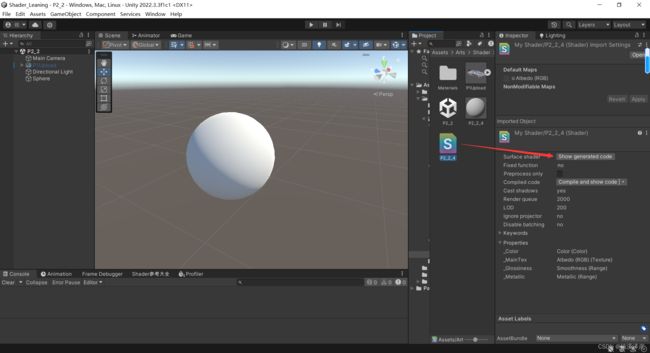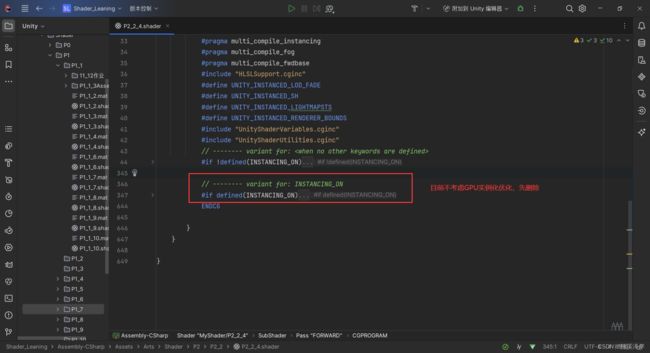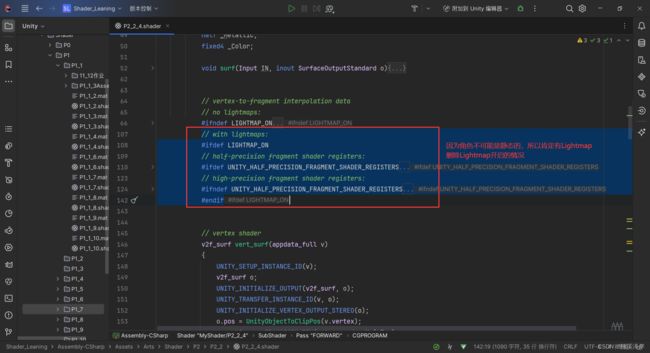Unity中Shader的Standard材质解析(一)
文章目录
- 前言
- 一、在Unity中,按一下步骤准备
-
- 1、在资源管理面板创建一个 Standard Surface Shader
- 2、因为Standard Surface Shader有很多缺点,所以我们把他转化为顶点片元着色器
- 3、整理只保留主平行光的Shader效果
- 4、精简后的最终代码
前言
在Unity中,实现PBR材质的Shader
一、在Unity中,按一下步骤准备
1、在资源管理面板创建一个 Standard Surface Shader
2、因为Standard Surface Shader有很多缺点,所以我们把他转化为顶点片元着色器
- 点击Show generated code
- 把生成后的,顶点片元着色器代码复制过去
- 这样我们就可以得到一个简单的PBR材质了
3、整理只保留主平行光的Shader效果
4、精简后的最终代码
最终效果:
- 给予对于纹理
//Standard材质
Shader "MyShader/P2_2_4"
{
Properties
{
_Color ("Color", Color) = (1,1,1,1)
_MainTex ("Albedo (RGB)", 2D) = "white" {}
[NoScaleOffset]_MetallicTex("Metallic(R) Smoothness(G) AO(B)",2D) = "white" {}
[Normal]_NormalTex("NormalTex",2D) = "bump" {}
_Glossiness ("Smoothness", Range(0,1)) = 0.0
_Metallic ("Metallic", Range(0,1)) = 0.0
_AO("AO",Range(0,1)) = 1.0
}
SubShader
{
Tags
{
"RenderType"="Opaque"
}
LOD 200
// ---- forward rendering base pass:
Pass
{
Name "FORWARD"
Tags
{
"LightMode" = "ForwardBase"
}
CGPROGRAM
// compile directives
#pragma vertex vert
#pragma fragment frag
#pragma target 3.0
#pragma multi_compile_instancing
#pragma multi_compile_fog
#pragma multi_compile_fwdbase
#include "UnityCG.cginc"
#include "Lighting.cginc"
#include "UnityPBSLighting.cginc"
#include "AutoLight.cginc"
sampler2D _MainTex;
float4 _MainTex_ST;
half _Glossiness;
half _Metallic;
fixed4 _Color;
sampler2D _MetallicTex;
half _AO;
sampler2D _NormalTex;
struct appdata
{
float4 vertex : POSITION;
float4 tangent : TANGENT;
float3 normal : NORMAL;
float4 texcoord : TEXCOORD0;
float4 texcoord1 : TEXCOORD1;
float4 texcoord2 : TEXCOORD2;
float4 texcoord3 : TEXCOORD3;
fixed4 color : COLOR;
UNITY_VERTEX_INPUT_INSTANCE_ID
};
// vertex-to-fragment interpolation data
// no lightmaps:
struct v2f
{
float4 pos : SV_POSITION;
float2 uv : TEXCOORD0; // _MainTex
float3 worldNormal : TEXCOORD1;
float3 worldPos : TEXCOORD2;
#if UNITY_SHOULD_SAMPLE_SH
half3 sh : TEXCOORD3; // SH
#endif
//切线空间需要使用的矩阵
float3 tSpace0 : TEXCOORD4;
float3 tSpace1 : TEXCOORD5;
float3 tSpace2 : TEXCOORD6;
UNITY_FOG_COORDS(7)
UNITY_SHADOW_COORDS(8)
};
// vertex shader
v2f vert(appdata v)
{
v2f o;
o.pos = UnityObjectToClipPos(v.vertex);
o.uv.xy = TRANSFORM_TEX(v.texcoord, _MainTex);
float3 worldPos = mul(unity_ObjectToWorld, v.vertex).xyz;
float3 worldNormal = UnityObjectToWorldNormal(v.normal);
//世界空间下的切线
half3 worldTangent = UnityObjectToWorldDir(v.tangent);
//切线方向
half tangentSign = v.tangent.w * unity_WorldTransformParams.w;
//世界空间下的副切线
half3 worldBinormal = cross(worldNormal, worldTangent) * tangentSign;
//切线矩阵
o.tSpace0 = float3(worldTangent.x, worldBinormal.x, worldNormal.x);
o.tSpace1 = float3(worldTangent.y, worldBinormal.y, worldNormal.y);
o.tSpace2 = float3(worldTangent.z, worldBinormal.z, worldNormal.z);
o.worldPos.xyz = worldPos;
o.worldNormal = worldNormal;
// SH/ambient and vertex lights
#if UNITY_SHOULD_SAMPLE_SH && !UNITY_SAMPLE_FULL_SH_PER_PIXEL
o.sh = 0;
// Approximated illumination from non-important point lights
#ifdef VERTEXLIGHT_ON
o.sh += Shade4PointLights (
unity_4LightPosX0, unity_4LightPosY0, unity_4LightPosZ0,
unity_LightColor[0].rgb, unity_LightColor[1].rgb, unity_LightColor[2].rgb, unity_LightColor[3].rgb,
unity_4LightAtten0, worldPos, worldNormal);
#endif
o.sh = ShadeSHPerVertex (worldNormal, o.sh);
#endif
UNITY_TRANSFER_LIGHTING(o, v.texcoord1.xy);
UNITY_TRANSFER_FOG(o, o.pos); // pass fog coordinates to pixel shader
return o;
}
// fragment shader
fixed4 frag(v2f i) : SV_Target
{
UNITY_EXTRACT_FOG(i);
float3 worldPos = i.worldPos.xyz;
float3 worldViewDir = normalize(UnityWorldSpaceViewDir(worldPos));
SurfaceOutputStandard o;
UNITY_INITIALIZE_OUTPUT(SurfaceOutputStandard, o);
fixed4 mainTex = tex2D(_MainTex, i.uv);
o.Albedo = mainTex.rgb * _Color;
o.Emission = 0.0;
fixed4 metallicTex = tex2D(_MetallicTex, i.uv);
o.Metallic = metallicTex.r * _Metallic;
o.Smoothness = metallicTex.g * _Glossiness;
o.Occlusion = metallicTex.b * _AO;
o.Alpha = 1;
half3 normalTex = UnpackNormal(tex2D(_NormalTex,i.uv));
half3 worldNormal = half3(dot(i.tSpace0,normalTex),dot(i.tSpace1,normalTex),dot(i.tSpace2,normalTex));
o.Normal = worldNormal;
// compute lighting & shadowing factor
UNITY_LIGHT_ATTENUATION(atten, i, worldPos)
// Setup lighting environment
UnityGI gi;
UNITY_INITIALIZE_OUTPUT(UnityGI, gi);
gi.indirect.diffuse = 0;
gi.indirect.specular = 0;
gi.light.color = _LightColor0.rgb;
gi.light.dir = _WorldSpaceLightPos0.xyz;
// Call GI (lightmaps/SH/reflections) lighting function
UnityGIInput giInput;
UNITY_INITIALIZE_OUTPUT(UnityGIInput, giInput);
giInput.light = gi.light;
giInput.worldPos = worldPos;
giInput.worldViewDir = worldViewDir;
giInput.atten = atten;
#if defined(LIGHTMAP_ON) || defined(DYNAMICLIGHTMAP_ON)
giInput.lightmapUV = IN.lmap;
#else
giInput.lightmapUV = 0.0;
#endif
#if UNITY_SHOULD_SAMPLE_SH && !UNITY_SAMPLE_FULL_SH_PER_PIXEL
giInput.ambient = i.sh;
#else
giInput.ambient.rgb = 0.0;
#endif
giInput.probeHDR[0] = unity_SpecCube0_HDR;
giInput.probeHDR[1] = unity_SpecCube1_HDR;
#if defined(UNITY_SPECCUBE_BLENDING) || defined(UNITY_SPECCUBE_BOX_PROJECTION)
giInput.boxMin[0] = unity_SpecCube0_BoxMin; // .w holds lerp value for blending
#endif
#ifdef UNITY_SPECCUBE_BOX_PROJECTION
giInput.boxMax[0] = unity_SpecCube0_BoxMax;
giInput.probePosition[0] = unity_SpecCube0_ProbePosition;
giInput.boxMax[1] = unity_SpecCube1_BoxMax;
giInput.boxMin[1] = unity_SpecCube1_BoxMin;
giInput.probePosition[1] = unity_SpecCube1_ProbePosition;
#endif
LightingStandard_GI(o, giInput, gi);
// PBS的核心计算
fixed4 c = LightingStandard(o, worldViewDir, gi);
UNITY_APPLY_FOG(_unity_fogCoord, c); // apply fog
UNITY_OPAQUE_ALPHA(c.a); //把c的Alpha置1
return c;
}
ENDCG
}
}
}









